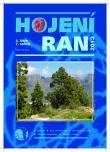The use of different materials for wound healing in patients with bed sores in selected health institutions in the Czech Republic and the Federal Republic of Germany
Authors:
Petra Langová 1; Iva Brabcová 2
Authors‘ workplace:
Geriatrische Reha, Kliniken Am Goldenen Steig, Freyung, Deutschland
1; Zdravotně sociální fakulta, Jihočeská univerzita v Českých Budějovicích
2
Published in:
Hojení ran 7, č. 4: 12-16, 2013
Category:
Bed sores
Overview
The main intent of the research investigation was to find out if the materials for wound healing used as the dressing of bed sores in the Czech Republic are different from those used in the Federal Republic of Germany. The results proved that the selection of a local therapeutic material is significantly different in the individual health institutions. Materials with silver and hydroactive superabsorbent pads TenderWet are more frequently used in the Czech Republic while transparent polyurethane dressings, secondary absorption dressings and polyurethane foams are more used in Germany. It is concluded that the availability of therapeutic materials for wound healing firstly depends on the decision of the management of the individual health institution.
Key words:
bed sore, wound healing, Czech Republic, Federal Republic of Germany
Sources
Čurdová, K., Škochová, D. Specifika fázového hojení ran v chirurgii. Diagnóza 8, 4: 14–15, 2012.
Kalvach, Z. Geriatrické syndromy a geriatrický pacient. Praha: Grada, 2008.
Kudělková, J., Veverková, L. Podtlakové systémy užívané v hojení ran u starších nemocných. Ošetřovatelská péče 4: 26–27, 2012.
Molčanová, J., Čech, M. Hojení ran vlhkou cestou. Diagnóza 7, 4: 7–9, 2011.
Pokorná, A., Mrázová, R. Kompendium hojení ran pro sestry. Praha: Grada, 2012.
Pospíšilová, A. Faktory ovlivňující hojení ran. In: Bureš, I. Léčba rány. Praha: Galén, 2006.
Sedláková, M. Antiseptická krytí se stříbrem a aktivním uhlím. Ošetřovatelská péče 4: 22–24, 2011.
Sedláková, M. Trendy a novinky vlhkého hojení ran. Ošetřovatelská péče 4: 22–23, 2012.
Stryja, J. et al. Repetitorium hojení ran 2. Semily: Geum, 2011.
Thiel, A. Wunden dechronifizieren mit negativ geladenen Polystyrol-Mikrosphären? Chirurgen Magazin 9, 6: 44–46, 2011.
Tlášková, J., Dolejší, L., Škochová, D. Moderní metody v hojení ran. Diagnóza 8, 3: 42–44, 2012.
Veisová, M. Výskyt dekubitů u seniorů – management dekubitů v ČR a SRN. Diplomová práce. Masarykova univerzita, Lékařská fakulta, Katedra ošetřovatelství, 2009. Dostupné z: http://theses.cz/ [cit. 2013-01-06]
Labels
Surgery Nurse Home nurseArticle was published in
Wound Healing

2013 Issue 4
- Metamizole vs. Tramadol in Postoperative Analgesia
- Metamizole at a Glance and in Practice – Effective Non-Opioid Analgesic for All Ages
- Spasmolytic Effect of Metamizole
- The Importance of Hydration in Wound Healing
- Obstacle Called Vasospasm: Which Solution Is Most Effective in Microsurgery and How to Pharmacologically Assist It?
Most read in this issue
- Free fibula in the reconstruction of mandibula, what are the pros and cons?
- The use of different materials for wound healing in patients with bed sores in selected health institutions in the Czech Republic and the Federal Republic of Germany
- Problems in the prevention of bed sores with respect to current experience and conclusions of the empiric studies
